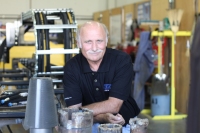
Features
Business
Success Stories
Sonic drilling pioneer to enter International Mining Hall of Fame
November 10, 2014 By Ground Water Canada

|
Nov. 10, 2014, Surrey, B.C. – Canadian engineer Ray Roussy will be
inducted into the International Mining Hall of Fame for his development and
commercialization of sonic drilling technology.

|
Nov. 10, 2014, Surrey, B.C. – Canadian engineer Ray Roussy will be
inducted into the International Mining Hall of Fame for his development and
commercialization of sonic drilling technology.
“I’m absolutely delighted to be recognized by my peers in this manner,”
said Roussy, who is president of the Sonic Drill Corporation and Sonic Drilling
Ltd, in a news release. “Sonic drilling technology has been
my life’s work and I’m thrilled with this honour.”
Roussy will be inducted into the Exploration category at the gala dinner in the Brown Palace Hotel, Denver, Colo., on Feb. 16, 2015.
Forty years after first beginning his research and
development efforts, Roussy holds dozens of patents involving sonic drilling
technology and is responsible for the successful commercialization of the technology, said the company in the release.
Roussy has received other honours for his technology, among them a recent nomination for an Ontario Premier's award by the Northern Ontario Institute of Technology.
Today, sonic drill rigs, patented and built by
the Sonic Drill Corporation, are in use on six continents and multiple applications. When it comes to
mineral exploration, sonic drilling technology has provided a substantial
advantage through its ability to core easily through mixed soils without
jamming up or requiring a rig switchout. In addition, it can recover a continuous core including
boulders, clays, silt, sand and gravel and lay it in its stratigraphic sequence
– from the surface all the way down to 300 feet (100 metres) and deeper, said the company in a news release.
Using Roussy’s patented sonic drill head, samples, ranging
from 3” to 8” in diameter, can be obtained from a wide variety of mineral
deposits including hard-to-extract oil sands, slag piles, mine tailings and
heap leach pads. Extruded into clear
plastic sleeves and then neatly laid out, these core samples can be subjected
to a detailed visual examination and analysis, followed by sampling,
photographing and archiving for a permanent record of the existing mineral
conditions. As well, cased holes,
provided by the sonic drilling technique, prevent the collapse of the borehole
and ensure that cores are not contaminated by up-hole debris.
Seven out of 10 sonic rigs are sold to mineral exploration companies, said the company.
Print this page